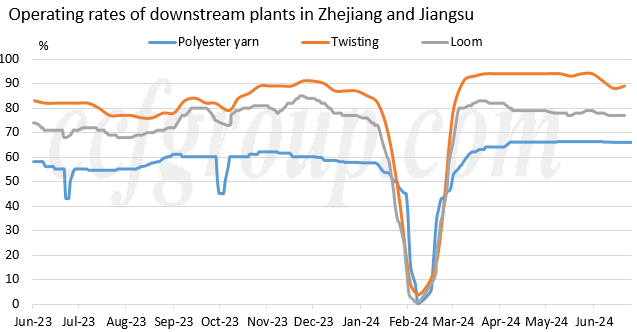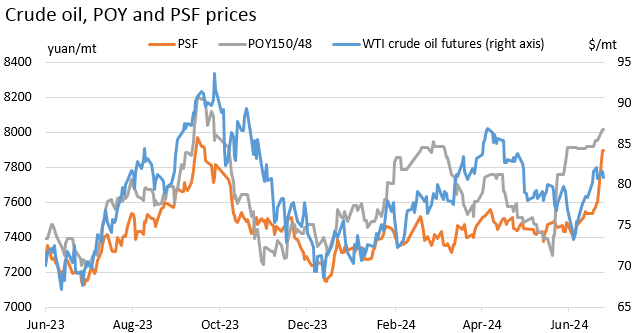PFY and PSF price hike: a test of affordability
China PFY and PSF producers are adopting pricing method based on polymerization cost plus processing cost, in order to ensure the processing spread. Some PSF producers have raised offers last weekend. And amid the concerns that PFY price could also be hiked, several downstream clients have increased the purchasing of PFY, driving up PFY sales to production ratio up to an average of 280% last weekend. Estimated based on the sales last weekend, POY inventory could be reduced by 3-4 days from last Friday's level.

The support to this round of price hike may come from stable operating rates of downstream plants. Though there's some seasonal drop, the operating rate of downstream plants (represented by looms, twisting units and polyester yarn mills) keeps quite stable, with regular demand for feedstock. Therefore, even though PFY inventory is high in some periods, producers are not in the rush to sell as feedstock inventory at downstream plants is quite low.

It seems that demand is not weak during the traditional slack demand season. As it is off-season now, selling opportunities later are the momentum to current production. Then, how is the price going?
As of Jun 21, direct-spun semi-dull POY 150/48 price has risen to 7955yuan/mt, compared to the high points of 7945yuan/mt in end-Feb this year and 8205yuan/mt in Sep last year. The same goes for PSF which also hits this year's new high.

In terms of processing spread, PFY processing spread has widened from 738yuan/mt in mid-May straightly to 1369yuan/mt as of Jun 21, while PSF processing spread has been hovering at around 1000yuan/mt this year and stayed at 934yuan/mt on Jun 21.
In a conclusion, PFY and PSF production has been keeping fast growth, regular demand is available, while the main issue is price. It is slack season in Jun, yet PFY and PSF price hike to high point and may continue to move up, which seems to be a test of affordability. If downstream plants can afford and keep running stably, it indicates that the demand is more resilient than we expect. If the price hike is not accepted, there could be some adjustment.
- Top keywords
- Cotton Price
- Cotton Futures Price
- Cotton Futures
- CZCE
- PTA Futures Price
- Chemical Fiber
- Polyester Prices
- Wool price
- PTA Futures
- Shengze Silk
- China
- Yarn Price
- price
- China Textile City
- Fibre Price
- Benzene Price
- Cotton
- Index
- Cotton Index
- PTA
- fabric price
- NYMEX
- Top 10
- textile industry
- Spot Cotton
- Cotton Yarn
- Polyester Price
- Futures
- PTA Price
- cotton yarn price

